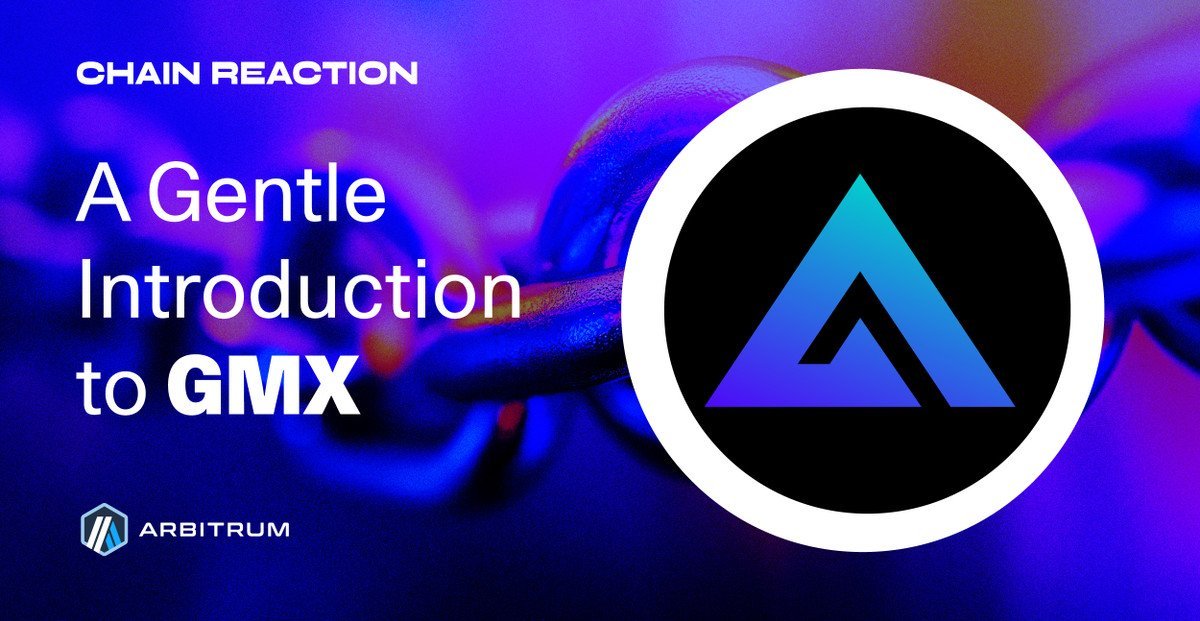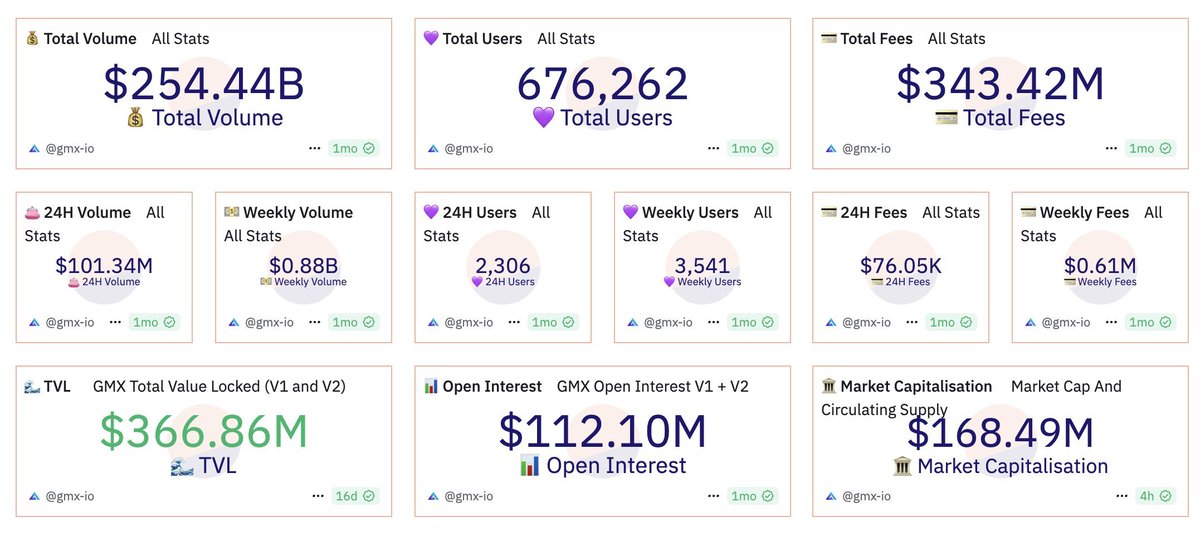Let's take a look at the ultra-detailed analysis that even GMX Chinese's official account @GMXCNofficial has forwarded!
Why is GMX called a useful tool-based protocol?
In the highly competitive DeFi track with new projects emerging one after another, what makes GMX an evergreen? 👇
GMX: A Small but Strong DeFi "Leverage Engine"
Can the "trading artifact" on the chain support the next DeFi bull market?
After the frenzy and trough of DeFi, when we look at GMX today, we will find that it is not a flash in the pan. This decentralized exchange, which has been coming all the way from 2021, has gained a firm foothold on Arbitrum, Avalanche, and even Solana thanks to its unique design.
The great thing about GMX is not that it "runs fast", but that it "lives long". Among the ups and downs of many DeFi derivatives platforms, it has attracted millions of traders around the world by relying on the three axes of low fees, high leverage, and user self-custody. Let's disassemble this star project, where is the strength, where is the danger, and how far can it fly?
🌸 ⋆。 ゚🐾。 ⋆。 ゚☾ ゚。 ⋆ 🌸
1️⃣ No custodial, low slippage, high leverage: what DeFi players want, it has
The biggest highlight of GMX is that it is not a "market maker exchange" in the traditional sense. You won't see it hanging a bunch of order books, and you don't need to deposit coins into it, users connect directly with wallets, and transactions are all on the chain, with first-class security.
In terms of trading experience, GMX focuses on zero-slippage spot + perpetual contract trading, up to 100 times leverage, and the handling fee is as low as 0.08%~0.12%, which is cheaper than Binance. And you can set stop-loss/take-profit, and even open positions in batches via TWAP, which even veteran players say is "silky smooth".
There are also many supported chains, in addition to the home stadium Arbitrum, there are also Avalanche and Solana, and in the future, they plan to open up more chains through LayerZero, such as BTC Layer 2 like Botanix, which shows their ambitions.
🌸 ⋆。 ゚🐾。 ⋆。 ゚☾ ゚。 ⋆ 🌸
2️⃣ The liquidity mechanism is smart: being an LP is no longer a "big loss of money"
GMX's liquidity mechanism has evolved significantly from V1 to V2:
V1's GLP pool is a multi-asset pool composed of a mix of ETH, BTC, USDC, and liquidity providers (LPs) that can earn trading fees and market-making income. The annualized rate of return has remained at 10%-20% all year round, which is stable and high-quality compared to the "air gains" of other DeFi projects.
V2's GM pool + GLV vault further introduces an asset segregation mechanism to match transaction risks as needed. To put it simply, it is to use hot money on the cutting edge to improve capital efficiency.
On the price oracle, GMX relies on Chainlink's low-latency data streams to provide real-time price feeds and reduce the risk of arbitrage, which is critical in high-frequency trading.
🌸 ⋆。 ゚🐾。 ⋆。 ゚☾ ゚。 ⋆ 🌸
3️⃣ The numbers don't lie: 300 billion transactions, who would dare to say it's small?
Let's take a look at a set of real data:
Cumulative trading volume: exceeded $300 billion, and it has been the leading derivatives company on Arbitrum for a long time;
Number of users: about 700,000 people, accounting for 10%-15% of Arbitrum's total active addresses, not to mention monopoly, half of the country;
Average daily trading volume: about $120 million in April 2025, which is still "blood flowing" in a bear market environment, which is enough to show that users are sticky;
LP yield: In the two modes of GLP and GLV, the annualized remuneration is basically maintained at 10%-20%, which is higher than that of most liquidity mining projects.
What do these numbers say? GMX is not a project that lives by shouting, it is a "product-based DeFi" with a real use case, a user base, and cash flow.
🌸 ⋆。 ゚🐾。 ⋆。 ゚☾ ゚。 ⋆ 🌸
4️⃣ The token mechanism is not complicated, but it is "useful"
GMX's native token is also called GMX, with a total of 13.25 million tokens, and about 10.1 million are currently in circulation, accounting for 76% of the total. The distribution mechanism is also relatively restrained, and there are not too many parts of "reserving leeks for cutting":
45.3% were reserved for early migration projects;
15.1% provides liquidity to Uniswap;
15.1% for incentives and 15.1% for price stabilization funds;
Teams make up only 1.9% and have 2 linear vestings.
GMX holders can participate in governance and stake to obtain income (including ETH dividends), with an annualized rate of 5%-15%, which belongs to the logic of "can vote and hold".
🌸 ⋆。 ゚🐾。 ⋆。 ゚☾ ゚。 ⋆ 🌸
5️⃣ "The strong are always strong"? Or is it "life hanging by a thread"? Let's take a look at the risks section
✅ The advantages are obvious:
Low cost + good experience: This is GMX's biggest competitiveness, especially after dYdX migrated to Cosmos and the user experience changed, many users returned to GMX;
Multi-chain layout: The addition of Solana can open up a new user market;
High capital efficiency: V2 introduces a vault model, so that LPs no longer become "cannon fodder".
⚠️ But the challenges are not small:
High Leverage = High Risk: 100x leverage makes GMX a "gambler's paradise" and easy to liquidate when the market is volatile;
Lack of fee transparency: Some users reported that the closing fee fluctuated too much, which affected the experience.
Team anonymity: While open source + audit is fine, it may not be conducive to institutional funding in the long run;
Fierce competition: dYdX and Hyperliquid are both evolving rapidly, especially the latter, which is rapidly emerging through the market-making experience.
🌸 ⋆。 ゚🐾。 ⋆。 ゚☾ ゚。 ⋆ 🌸
6️⃣ Looking ahead to 2025: Can GMX on Solana be the new pivot?
By the end of 2025, GMX is expected to complete the deployment of the Solana ecosystem, with the goal of increasing its trading volume to 20%-30%. If the Solana ecosystem continues to expand (from DePIN to gaming to stablecoins), GMX may see a second wave of growth.
In addition, through cross-chain protocols such as LayerZero, GMX is also trying to "redistribute on-chain traffic", and even integrate the BTC ecosystem (such as Botanix) in the future, which may bring new trading vitality to the originally relatively isolated Bitcoin assets.
🌸 ⋆。 ゚🐾。 ⋆。 ゚☾ ゚。 ⋆ 🌸
✅ Bottom line: It's time to take a serious look at GMX
GMX isn't the latest DeFi project, but it's one of the few instrumental protocols that really "work". In the context of the current market downturn, liquidity fragmentation, and increased regulatory pressure, it has delivered a steady answer sheet with the simplest combination of "low cost + high leverage + self-custody".
It's imperfect and risky, but it also smacks of long-termists.
For LPs looking for stable income, traders looking for an efficient experience, or investors looking for an ambush at a low valuation, GMX is worth putting on your watchlist.
@arbitrum @arbitrum_cn @KaitoAI @0xchewieee




15.99K
2
The content on this page is provided by third parties. Unless otherwise stated, OKX TR is not the author of the cited article(s) and does not claim any copyright in the materials. The content is provided for informational purposes only and does not represent the views of OKX TR. It is not intended to be an endorsement of any kind and should not be considered investment advice or a solicitation to buy or sell digital assets. To the extent generative AI is utilized to provide summaries or other information, such AI generated content may be inaccurate or inconsistent. Please read the linked article for more details and information. OKX TR is not responsible for content hosted on third party sites. Digital asset holdings, including stablecoins and NFTs, involve a high degree of risk and can fluctuate greatly. You should carefully consider whether trading or holding digital assets is suitable for you in light of your financial condition.


